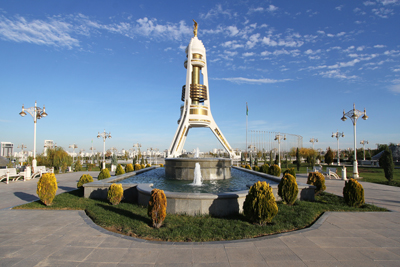
Originally located in Ashgabad, the capital and largest city of Turkmenistan, the Monument of Neutrality, a 246 feet (75 m) tall gigantic three-legged rocket shaped arch, which later became locally known as the Tripod, was initially named Arch of Neutrality, to commemorate the country's official policy of neutrality. Built in 1998, at the initiation of the then president of Turkmenistan, Saparmurat Niyazov, at the cost of $ 12 million, it was originally 312 feet (95 m) tall, topped by a 39 feet (12 m) tall gold-plated statue of Niyazov which rotated always to face the sun and dominated the skyline, being taller than the nearby Presidential Palace.

As the United Nations General Assembly recognised the permanent neutrality of Turkmenistan on 12 December 1995, the country began to celebrate 12 December as the Day of Neutrality and the same year the idea of constructing a monument to commemorate the event was conceived.
In the next year, the Turkish company Polimer launched the construction of the proposed structure, by a decree of Saparmurat Niyazov and the ceremonial inauguration of the Arch of Neutrality took place on 12 December 1998, in the heart of the capital city, where it stood till 2010.

Saparmurat Niyazov was infamous as one of the most despotic, totalitarian and repressive dictators of his time. He promoted a cult of personality around himself, pronounced himself Turkmenbashi or Father of All Turkmen and gilded the country with his own image.
He exerted extensive control over the country and despite the country having the world’s fourth-largest gas reserves, its five million people lived mostly destitute, while he spent indiscriminately to construct lavish monuments. He made it mandatory to read his autobiography, Ruhnama, in schools, universities and governmental organizations, even new governmental employees were tested on the book at job interviews and anyone taking the driving test. He not only renamed the days, months, a moon crater and a meteorite, airports and a city after himself and members of his family, even changed the Turkmen word for bread to the name of his late mother. In 2005, he closed down all rural libraries and hospitals outside of the capital city and imposed personal laws to prohibit beards, long hair, opera, ballet, and circuses. He never tolerated his political opponents or any person questioning about his authoritarian activities.

Niyazov died of heart failure in 2006 and his successor, Gurbanguly Berdymukhamedov, signed a decree on 18 January 2010, to dismantle the Arch of Neutrality and reassemble it on the outskirts of Ashgabat, after the removal of the golden statue of Niyazov.
The new edition of the structure, including the non rotating golden statue of Niyazov, raising the arms to the sky on the background of a waving flag, was inaugurated as the Monument of Neutrality in December 2011, in a southern part of Ashkhabad, on Bitarap Turkmenistan Avenue, a passage of the largest highway.

The huge structure of the monument, lined with white marble, rests on three pylons, each equipped with an elevator, interconnected with the support of disks and rings of different diameters and thicknesses to support the sky decks. The monument is decorated with several bronze bas reliefs, exhibiting the most important events of forming of Turkmen statehood, beginning from the nation of Oguz khan Turkmen with six of his sons, along with the image of ancient historical monuments and soldiers on Turkmen Akhal-Teke horses, known for their speed, endurance and intelligence and pictures of the daily life of Turkmens. The vertical part of the pylons is hooped with five bronze rings with national ornaments of Turkmen carpets, signifying the number of the Turkmen tribes. The multi-level monument includes two sky decks or observation platforms. While a café-bar at the height of 71.53 feet (21.5 m) greets the visitors with an excellent panorama of the city, a transparent elevator lifts the visitors even higher, at the height of 164 feet (50 m) to reach an upper sky deck.

The Monument of Neutrality houses a small museum, devoted to pages of the recent history of Turkmenistan. Surrounded with a landscaped park zone, equipped with decorative fountains, wooden shelters and cafes, the massive structure of the monument, illuminated with colourful lights, offers a pleasing sight after dusk.